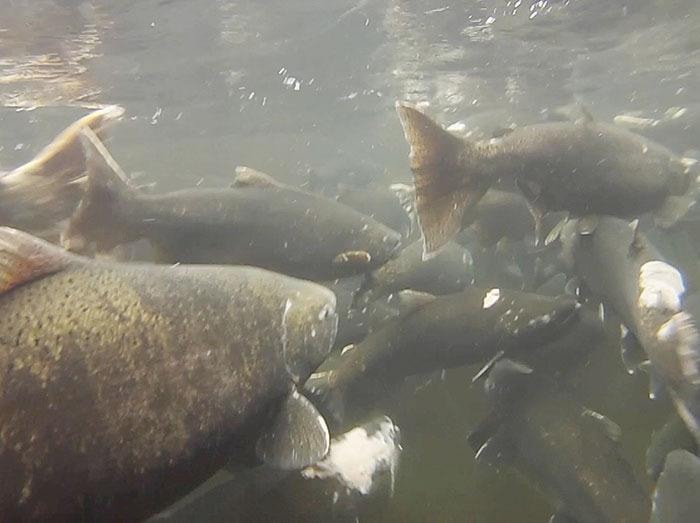Campbell River’s Quinsam Hatchery has signed up 880,000 chinook salmon for Ancestry.com.
Sort of.
The chinook eggs were placed in the motherly waters of the Campbell River Dec. 21. Secure in incubator boxes, they spent Christmas and now the early months of 2017, growing into young salmon before being released in early March to begin their three-, four- and five-year migrations out to the ocean and back to their maternal waters.
And when they come back, their lineage will be linked to their individual fathers and mothers.
It is that specific.
It is also a relatively new technology relying on DNA and its implications on what is called heritability — or what, exactly, is handed down to the offspring from their parents. Previous information relied on CWTs (coded wire tags), but that information only gave details on groups of fish, not individuals.
The goal is to find out what pairings of adult salmon will produce the best progeny to re-build the historic chinook salmon stock in the Campbell River. That stock helped give Campbell River its reputation as Salmon Capital of the World. It was a stock of huge chinooks, Tyees of 30, 40, 50, 60 and even 70 pounds.
With the average size of chinook salmon shrinking coast-wide, a recipe for larger fish would be a boon, especially to the Tyee Club of British Columbia — whose nearly 100-year-old tournament requires the catching of a chinook salmon of 30 pounds or over for membership.
In recent years, registered fish into the club have dwindled to the teens, from previous years of 50 to 100 or more salmon of 30 pounds or more. (Historic highs of Tyee salmon registered in the club were in the hundreds.)
But Quinsam Hatchery manager Laurent Frisson stresses that the new program is not just for the Tyee Club, it is strictly to get to the roots of what type of chinook can best replenish the Campbell stocks.
“It’s not about that at all, we’re trying to determine the heritability from parents to offsprings and the size thing is just one thing to look at,” he said. “The reason we’re doing it is we want to find out what they inherit from whom, do they inherit it from the female or from the male, does it even happen? You look at the Campbell system and the way the Campbell system is; we’re trying to produce a fish that can thrive in the Campbell and that ain’t no small fish.
“If you look at it naturally, the smaller adults would not be able to dig appropriate redds, and nature would take care of it. We’re not trying to produce fish for a particular club or a particular group.”
And, yes, the small, short, little Campbell is such, with heavy water flows, in-river habitat and larger spawning redd gravel, that it favours larger fish.
“What we’re doing is a heritability study between the adults and then their offspring and one of the things we can look at is size, what do they inherit from parents to off springs,” said Frisson. “We don’t just spawn big fish with big fish but also big fish with medium and small fish and then in three, four, or five years get the DNA.
“Then we can say ‘look that’s the offspring from A, size X and that’s the offspring from two big ones or a big one and a small one,’ and hopefully over time, we can say yes, it makes a difference or no, it doesn’t make a difference.”
It’s called PBT (Parental Based Tagging).
In layman’s terms, previous CWT information gave hatchery managers information on ‘neighbourhoods’ of fish. The PBT gives them information right down to individuals.
“These fish, these parents that were used for this study, have all been DNA’d,” said Frisson. “When the juveniles come back that’s how we’re going to tell whose offspring they were through the DNA sample.
“The CWT information is a big group — it’s released on that date raised on this type of food etc. — but it doesn’t get down to the nitty gritty detail of PBT. We’re just trying to figure out if we spawned a large fish with a large fish, did it make any difference?
“So, with the same female, part of her eggs are mated with a large male fish and part of the eggs with a small male. What did we produce out of it? Did we produce a large fish or were they all over the place? And, hopefully, we might find out what works.”
The project, in its second year, is supported by the Campbell River Salmon Foundation, BC Hydro, Ecofish and the A-Tlegay Fisheries Society.
The DNA is taken from the caudal fin of the chinook, the tail section. Anyone who has ‘wristed’ a Campbell River chinook, knows that gripping its tail takes a big hand, because it is usually a big fish.
“With the Campbell’s stream size and habitat, the larger fish would be more successful, being able to hold in the current, spawn in the current, dig that size gravel and be successful. Naturally if you were a smaller fish you wouldn’t be as successful as a larger fish. But, we’ll see,” said Frisson.
In 2019, the Quinsam River Hatchery’s program will get its first taste of what their version of Ancestry.com has to offer.
